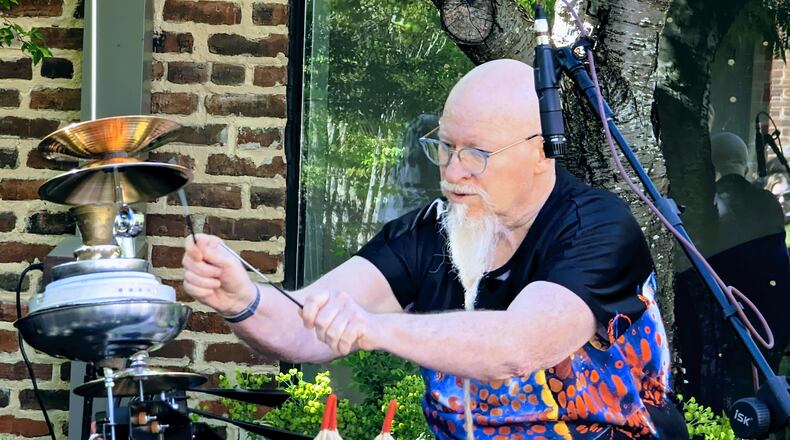This story was originally published by ArtsATL.
German philosopher and aspiring Übermensch Friedrich Nietzsche argued that chaos produces order — that it is out of the random and the wild that structure and form eventually emerge. On April 6, the mononymous avant garde musician Klimchak gave an outdoor concert at Atlanta Contemporary museum that proved Nietzsche was occasionally correct.
The event was the third in Klimchak’s “Ear Pollen, Part 2″ series of four concerts at the Contemporary in which he collaborates with a different improvisation partner at each performance. This time he was joined by Chattanooga, Tennessee-based drummer/percussionist Bob Stagner.
(Guitarist Bill Taft and keyboardist Ipek Eginli appeared at the first and second performances, respectively, and violin/mandolin multi-instrumentalist Majid Araim will join Klimchak on May 4 at 4 p.m. for the final installment.)
Describing Klimchak’s sound to those unfamiliar with the man and the distant musical galaxy he occupies is a daunting task. His live rig is a rotating assortment of electronically modified percussion instruments, microphones, effects pedals, cymbals, a theremin (an electronic instrument operated by swoops of the hand that made up the background sounds of many vintage horror movies) and seemingly random gizmos. It all comes together to form something that often is as enjoyable and captivating as it is unfocused and galling.
Put it this way: Conservative news personality Ben Shapiro famously argued that rap wasn’t music because music requires rhythm, harmony and melody, with rap only providing one of the three. In the case of Klimchak’s sound, all three elements are present but not in an easily digestible manner. They come together only in passing as moments of clarity in an otherwise beguiling sonic tapestry. It’s a wonder to behold but still very much an acquired taste.
Credit: Photo by Paula Novelle
Credit: Photo by Paula Novelle
Stagner was more than ready to meet Klimchak at his level. Stagner’s instrument — though arranged in the format of a traditional drum kit — was similarly rigged up with electronics and hidden effects that turned his percussive phrases into melodic patterns and sustained ambiance.
Together they created an engaging sonic dialogue that danced back and forth for long stretches before coalescing into surprisingly cohesive statements of rhythmic intricacy.
Stagner is the founding officer and deputy director of the Shaking Ray Levi Society, a nonprofit arts and education collective that nurtures and promotes avant-garde music in the Chattanooga area. The organization has existed since 1986 and has brought numerous experimental music legends to its city, including Laurie Anderson, John Zorn and Rock in Opposition pioneers Chris Cutler and Fred Frith.
That impressive list of connections goes a long way toward explaining the musical mind-set on display in the Ear Pollen, Part 2 series.
A bit of history: Cutler was a leading innovator in merging the acoustic drum set with electronic components to create rhythmic noise art. Zorn was a creative force behind the “game piece” musical concept in which improvising musicians are stripped of all melodic, rhythmic and harmonic structures and are left with only an agreed upon framework regarding how to musically interact with one another. To the untrained ear, these abstract concepts would hardly be intuitive, but, for avant-garde enthusiasts with a well-trained palette, a rich vocabulary is readily apparent.
Klimchak and Stagner’s musical dialogue was, in its own odd way, listener friendly. Their gentle approach to abstract noise music lacked the unrestrained mania of Merzbow, the ominous brooding of Nurse With Wound or the militaristic ferocity of NON. Instead, they offered a soft and meditative aura in their sonic chaos that got as close to easy listening Muzak as such otherworldly sounds ever could.
It is that sense of restraint that makes Klimchak a treasure in the realm he occupies. Most improvisational extremists go for gusto from the outset and seldom let up. But Klimchak and company are meditative and genteel in their approach. Such self-imposed maturity in the lawless outback of experimental music makes for a satisfying experience.
Credit: Photo by Paula Novelle
Credit: Photo by Paula Novelle
The players had moments of genuine inspiration as a duo, but it was their solo pieces that produced the most engaging results. Stagner’s was a more traditional drum solo with clear nods to the showy, chops-heavy stylings of Max Roach. There was auditory manipulation and deliberate weirdness along the way, but, overall, it was the most accessible part of the afternoon.
Klimchak leaned heavily on his rack of cymbals, creating sounds Western ears might associate with sacred music of various Asian countries. It was, like Stagner’s piece, a more familiar and inviting affair than the fiendishly multilayered duo improvisations.
The two musicians wisely brought things to a close at just under an hour. The audience may have been a robust showing of Klimchak’s devoted following, but even such ardent listeners can only commit to so much experimentation.
Klimchak proved once again that he is a window into a surreal sonic world that reliably satiates the sound-as-art set. Hopefully, Klimchak’s next series of concerts will be indoors — “Ear Pollen” didn’t pair particularly well with actual pollen.
::
Jordan Owen began writing about music professionally at the age of 16 in Oxford, Mississippi. A 2006 graduate of the Berklee College of Music, he is a professional guitarist, bandleader and composer. He is currently the lead guitarist for the jazz group Other Strangers, the power metal band Axis of Empires and the melodic death/thrash metal band Century Spawn.
Credit: ArtsATL
Credit: ArtsATL
MEET OUR PARTNER
ArtsATL (artsatl.org) is a nonprofit organization that plays a critical role in educating and informing audiences about metro Atlanta’s arts and culture. ArtsATL, founded in 2009, helps build a sustainable arts community contributing to the economic and cultural health of the city.
If you have any questions about this partnership or others, please contact Senior Manager of Partnerships Nicole Williams at nicole.williams@ajc.com.
About the Author
Keep Reading
The Latest
Featured





